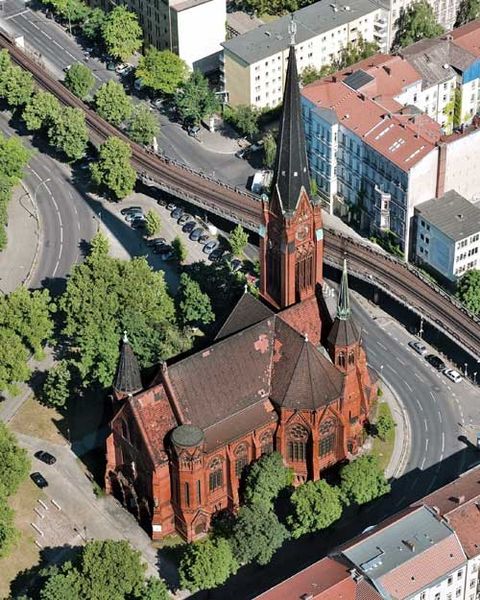When did ACB begin?
The German-American American Methodist Episcopal (ME) missionary preacher Ludwig Nippert was given the approval to open a church in the large hall of his Klosterstrasse apartment on the first Sunday in January 1859. An English service was at 16:00. Understanding “church” as a body of believers, not a building, this service is the earliest worship service of what would later be named the American Church in Berlin.
A Chapel is Built
In 1876 German and English language services were moved from a succession of preachers’ apartments into the newly-built ME Chapel on Junkerstrasse. This quickly became known as the American Chapel. The English services were preached both by the ME missionaries themselves and by American post-graduate theology students from Berlin University (today, Humboldt). The services were ecumenical and non-denominational. The English-speaking congregation consisted of American students, Legation personnel, American businessmen residing in Berlin, and members of the permanent American community in the city.
The Rev. Dr. J. H. W. Stuckenberg, a retired Lutheran professor, arrived in Berlin in 1880, became one of the guest preachers, joined the chapel committee, and by 1886 had become the first full-time pastor of the American Chapel. He changed the name from Chapel to Church, and set up the church’s first constitution. He supported the Ladies’ Union of the church in starting a drive to collect money for an independent American Church.
A Beginning and an End
The Rev. Dr. James F. Dickie, a Presbyterian, led the church from 1894 to 1908, holding ecumenical services in English in the great hall in the YMCA building on Wilhelmstraße before completing the fund drive for and the construction of the American Church in Berlin on Motzstrasse at Nollendorfplatz. This new church was consecrated in 1903 and remained ACB’s home through the First World War, the ‘roaring twenties’, and the 1930s.
In 1941 the pastor Rev. Stewart W. Herman, closed the church and was ordered out of Germany. He left before bombs destroyed his church in 1943. Herman was able to rescue a limited number of records, which formed the basis for his 1978 history of the American Church.
The Post-War Church Dies and a New Church is Born
When the Rev. Dr. Arthur R. Siebens, a Presbyterian, was sent to Berlin in 1946 by the American and Foreign Christian Union (AFCU), the American military government encouraged him to reconstitute the ecumenical and non-denominational American Church as part of the healing process for Berlin. But his church did not survive the defection in 1955 of American Lutherans who wanted a more liturgically Lutheran worship service.
The Lutherans organized their own Lutheran American Church in Berlin (LACB) in 1961, and LACB moved its services to the Alte Dorfkirche in Zehlendorf in 1964.
LACB, under the Rev. Alan C. Bray (pastor 1986-1991), abandoned the name ‘Lutheran’ in 1987. The restored American Church in Berlin (ACB), now legally assumed the history and lineage of the historic pre-war ecumenical and non-denominational church.

In November 2002 ACB left the Dorfkirche in Zehlendorf which it had outgrown, and began English services in the rented Luther Church in Schöneberg, purchasing it on November 12, 2007.
ACB’s social impact on its neighbourhood includes an annual street fair, the weekly Laib und Seele food distribution program for the needy, and free English and German lessons. ACB works closely with the German churches in this part of Schöneberg, and is a leader in the carolling service in the Berliner Dom every December.
Charles H. Eypper, M.A.
Church Historian


